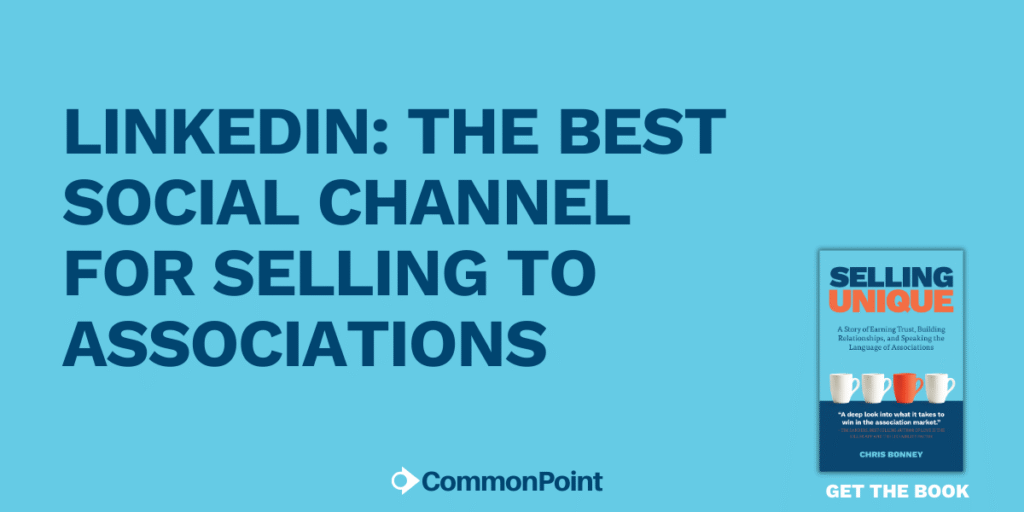If you sell into the association market, you already know how hard it is to get attention.
Cold calls ring hollow.
Trade show encounters are hit-or-miss.
And even the cleverest email sequences often end in silence.
It’s not because associations don’t need what you offer—it’s because they’re wired to be cautious.
Their culture is consensus-driven. Their reputations depend on trust. And nobody inside an association wants to be the one who championed a vendor that blew up six months in.
That’s why LinkedIn matters so much.
It’s not just another platform where professionals scroll during lunch breaks.
It’s become the place associations quietly go to check you out. They’re looking at your profile, scanning your posts, and forming an impression long before they ever reply to an email or consider your proposal.
And here’s the uncomfortable truth: if your LinkedIn presence is an unbranded wasteland, you’ve already lost ground.
Why LinkedIn Is Different
LinkedIn isn’t just where people go to job hunt anymore. It has become the default professional stage where credibility is established. Consider this:
- Over 61 million decision-makers are active on LinkedIn every month【1】.
- Four out of five members on the platform are directly involved in driving business decisions【1】.
- In fact, 82% of B2B marketers report that LinkedIn consistently delivers the most success compared to other social platforms【2】.
These numbers aren’t just broad B2B trivia. They are a mirror of how associations operate. Staff use LinkedIn to follow peers, track trends, and yes, quietly size up potential partners.
In a consensus culture where decisions take time, LinkedIn is the one place that allows them to observe you, safely, over weeks or months.
Think about what that means. By the time your email lands or your name comes up in a meeting, they already have a sense of you. They know whether you’re credible or forgettable—before you ever step into the room.
The Problem With How Vendors Show Up
Unfortunately, most vendors don’t do themselves any favors here. Their LinkedIn presence reads like a running press release:
- “We’re excited to announce another seamless integration!”
- “Our all-in-one solution just got even more powerful!”
- “We’re revolutionizing engagement for associations everywhere!”
The intent isn’t bad. But the effect is sameness. When every vendor says essentially the same thing, association executives scroll right past. They’ve seen these phrases before. They sound like copy-paste marketing.
And more importantly, they don’t reflect an understanding of the real challenges association leaders wrestle with: board expectations, member engagement, staffing limitations, and budget pressures.
When your content doesn’t acknowledge those realities, it doesn’t just fall flat. It signals that you don’t really “get” associations.
A Framework That Works
At CommonPoint, we’ve spent years helping vendors in this space show up differently.
What we’ve learned is that success on LinkedIn doesn’t come from louder sales pitches.
It comes from proving you understand the association world and are capable of speaking its language.
To make that concrete, we use what we call the Four-Part LinkedIn Framework:
1. Voice of Association
Your posts need to sound like you’ve been in the boardroom, not just the demo room.
Associations don’t care about a list of integrations. They care about what those integrations mean for staff and members.
Instead of saying, “Our AMS integrates with 100+ tools,” you might say, “When staff spend less time toggling between systems, they spend more time serving members—and that’s what your board notices.”
That shift—from features to impact—is what separates noise from resonance.
2. Proof Assets
Associations are conservative by design. They don’t gamble on unproven vendors.
Which is why you need to consistently provide evidence of your value. Not just once in a polished case study, but as a steady rhythm of small “proof points” in your feed.
That could be a quick before-and-after snapshot of a process improvement. Or a short story about how one client reduced onboarding time by half. Even anonymized examples work.
Why does this matter? Because posts that contain data or proof points see 2.3x more engagement on LinkedIn【3】. Associations want to reduce risk. Proof does that better than any adjective.
3. Conversation Hooks
Associations thrive on dialogue.
They don’t want to be talked at.
They want to feel part of a conversation.
Which means your posts shouldn’t end with “Click here for a demo.”
They should invite response.
Try prompts like:
- “What’s the most overlooked member engagement challenge you’ve run into this year?”
- “Hybrid events: headache or opportunity? What’s been your experience?”
The point isn’t to rack up likes. It’s to establish yourself as someone who knows how to spark thoughtful exchange—the same kind of exchange association staff value in their own communities.
4. Consistency Engine
The best-crafted post won’t matter if it’s a one-off. What signals credibility is consistency.
LinkedIn’s own research shows that companies who post weekly see 2x higher engagement compared to those who post less frequently【4】.
But the real payoff isn’t just in the algorithm.
It’s in what consistency communicates: that you’re invested in the space for the long haul, not just parachuting in when you need leads.
A thoughtful weekly post will always do more for your reputation than a flurry of updates every quarter.
Why This Approach Works
When you put these four pieces together—Voice of Association, Proof Assets, Conversation Hooks, and Consistency—you change the way associations perceive you.
Instead of being the cold caller with a keyboard, you become the familiar name that’s been showing up for months with relevant, credible, human content.
Staff notice, even if they never hit “like.” Executives remember.
And when your name comes up in the room where decisions are made, you’re already part of the mental shortlist.
I’ve seen it happen. Staff who never once commented on a vendor’s post later referenced that vendor by name in a closed-door RFP discussion. Silence on LinkedIn doesn’t mean nobody is watching. It often means the opposite.
The Long Game
LinkedIn isn’t about lead generation in the traditional sense. It’s about building the infrastructure of trust.
And in the association market, trust is the currency that determines who gets invited in and who gets left out.
By showing up with the Voice of Association, backing it with steady proof, sparking conversations, and sticking to a rhythm, you start looking less like an outsider trying to sell something and more like an insider who belongs in the conversation.
And when it’s time for an association to make a choice, insiders always have the advantage.
Want to know how your LinkedIn presence stacks up? At CommonPoint, we run quick audits that show where your Voice of Association is landing—and where it might be costing you credibility. If that sounds useful, let’s talk. https://www.commonpoint.co/#ContactUsForm
Sources
- LinkedIn Business: LinkedIn Pages Overview
- Content Marketing Institute: LinkedIn Remains B2B Marketers’ Top Social Channel
- LinkedIn Marketing Solutions Blog: Data on Content Engagement
LinkedIn B2B Institute: The B2B Institute Insights


